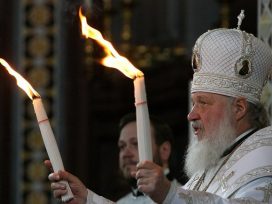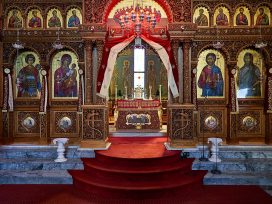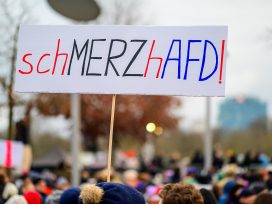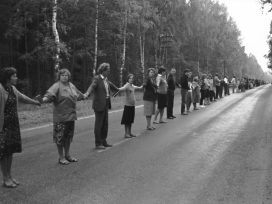In 2010, more than 50 castles and former church buildings – in many cases, merely their ruins – which had belonged to various religious communities before World War II, in what is now the Kaliningrad Oblast, were reassigned to the Orthodox Church of Russia. This tells us a good deal about the implementation of a new law, initiated by the Church and prepared by the Russian Ministry of Economic Development in February 2009 and which came into force on 1 January 2011, though the Kaliningrad Oblast saw preparations for the enforcement of the law as early as 2009.
The law states that property which had belonged to religious communities before the Bolshevik revolution of 1917 and was nationalized afterwards, must be returned to its former owners. As some critics have warned, the enforcement of the law will turn the Orthodox Church of Russia into the country’s largest independent landowner. Until 1945, when the region was annexed from Germany, the majority of the buildings used for religious purposes in this territory had belonged to the Evangelical Lutheran Church and the remaining ones to the Roman Catholic Church and local Jewish communities. The Russian federal law makes no concessions to the specific circumstances of the region. This poses two questions: What would happen if the Lutheran, Catholic and Jewish communities were to claim their former property? If the property were returned to them, would these communities want and be able to sustain it?
It is questions such as these that have prompted the Russian Orthodox Church to initiate a process whereby it takes possession of the buildings in question. On 2 November 2010, the Kaliningrad Eparchy of the Orthodox Church of Russia offered an official explanation in which it specified that the attempts to initiate the takeover of the property were motivated by the fact that the majority of the population in the region is Orthodox, and that their rights would be violated if the old churches were returned to other religious communities.
As early as 31 March 2009, the Holy Synod of the Russian Orthodox Church decided to split the Smolensk-Kaliningrad Eparchy, thereby establishing a separate Kaliningrad Eparchy with Patriarch Kirill of the Church of Russia as its head. In May 2009, the Patriarch approached the Russian Prime Minister Vladimir Putin, asking him to hand over the old Königsberg (now Kaliningrad) Cathedral to the Orthodox Church. At the same time, the administration of the region received requests from the Eparchy regarding the churches of Allenau (Poretchye), Allenburg (Druzhba), Domnau (Domnovo), Abschwangen (Tishino), Tharau (Vladimirovo), Kumehnen (Kumachevo) and Heiligenwalde (Ushakovo), which have survived since the times of the Teutonic Order, formed towards the end of the twelfth century. In July 2009, spokesmen of the Eparchy also approached relevant Russian institutions about the reassignment to it of several castles of the Order in the Kaliningrad Oblast, namely the castles of Georgenburg and Schaaken. In the autumn of the same year, the local administration was asked to resolve the issue of reassigning other buildings to the Church, including the former Roman Catholic Church of the Holy Family and an adjacent priest’s house, now used by the Kaliningrad Philharmonic, and the Lutheran Church built in memory of Queen Louise, which now hosts the Regional Puppet Theatre.
In all, almost 40 buildings under federal jurisdiction, such as the Georgenburg castle near Insterburg (Chernyakhovsk), the former Evangelical Church of Christ in Ratshof, or the churches of Tharau, Allenburg, have been reassigned to the Russian Orthodox Church since February 2010. The process continues: Vladimir Putin issued a new decree on 16 September 2010. The reassignment of buildings under the local jurisdiction was first discussed in the Kaliningrad Duma in October. It proposed that 16 buildings be handed over to the Orthodox Church, including the former church of Tollmingkehmen (Tchistye Prudy), which holds the museum of the classic of Lithuanian literature Kristijonas Donelaitis.
In a letter to the Speaker of the Kaliningrad Duma, the head of the Committee of Foreign Affairs in the Lithuanian Parliament, Emanuelis Zingeris, expressed his concern at these processes; the Consul General of the Lithuanian Republic in Kaliningrad, Vaclav Stankevic, had already expressed similar anxieties. During the Duma session of October 28, the current governor of Kaliningrad Nikolay Tsukhanov suggested taking the Tollmingkehmen church off the initial list; however, the question of its handing over to the Orthodox Church has only been indefinitely postponed. So far, it has been decided to hand the Russian Church 15 buildings: 14 churches and castles, including the Catholic Church of the Holy Family and the adjacent priest’s house, the Lutheran Church in memory of Queen Louise, the castles of Neuhausen, Taplacken, Labiau and Insterburg, and the ruins of the castles of Caymen, Ragnit and Gerdauen, as well as the church of Arnau, which was added in a separate decision.
This poses a further question: why does the Russian Orthodox Church need these castles built by the Teutonic Order and the old Lutheran or Catholic churches of East Prussia?
Until now, the population of Kaliningrad Oblast has been connected to the rest of Russia through the annual commemoration of the “Great Patriotic War” of 1941-1945. “The Great Patriotic War” was, and continues to be, the major historical narrative uniting the entire Russian population, the symbols of which were exploited in the Soviet period, particularly under Brezhnev, to strengthen Soviet patriotism. In the Kaliningrad Oblast, the remembrance of the war and, especially the constant actualization of the narratives of victory and liberation, have made them part of the local foundational myth, a sacralized story which explains and legitimates the political and social order of the region. None of this has changed since the collapse of the Soviet Union in 1991.
However, in the past decade, another tendency has become manifest, one that fuels the feeling of dependency on Russia among the population of the enclave by exploiting religion and, specifically, the Russian Orthodox Church. On a symbolic level, this change became strikingly visible with the reconstruction of a major area in Kaliningrad, Victory Square, in preparation for the festivities celebrating the 750th anniversary of the founding of the city. The statue of Lenin, the central icon in the square for 46 years, was removed and replaced by two other constructions: a triumphal column to celebrate victory in the Great Patriotic War and the Orthodox church of Christ the Saviour. The new symbols, imposed from “above” in 2005, clearly signalled the directions attempts to bring the people of Kaliningrad closer to Russia were going to take. The rapidly increasing number of Orthodox churches in the Kaliningrad Oblast is symptomatic of the same process. In 2009 alone, eight new churches were under construction in this relatively small territory, five of them located in Kaliningrad city.
The development of a network of Orthodox churches and their obviously increasing influence in the Kaliningrad Oblast could replace the entire sets of meanings which have been attached to heritage sites over the years. For instance, until 2006-2007, Kaliningrad had a single cathedral, in which many citizens took pride not only because it is one of the few examples of fourteenth-century Gothic architecture in the city, but also because of its connections with Immanuel Kant, whose grave lies adjacent to the northern wall of the cathedral. However, its place has now been claimed by the newly built Orthodox Church of Christ the Saviour on the Victory Square. Even though plans to hand over the old Königsberg Cathedral to the Russian Orthodox Church have been abandoned thanks to German Chancellor Angela Merkel’s mediation with Vladimir Putin, the massive takeover of the “German” heritage by the Orthodox Church suggests that this is a campaign to replace the “foreign” values of the predominantly German heritage with more “familiar” Russian values, of which the Orthodox religion is an especially significant part. Could this be a preventive measure to forestall any anticipated particularism among the local population?
The speculations of an outsider may well be accused of subjectivity. However, on 3 November 2010, fifty employees of the cultural institutions of the Kaliningrad Oblast, scholars and social activists signed an open letter to the leaders of the Russian Federation and the Russian Orthodox Church in reaction to the decision of the Duma. Their letter expressed concern at the process and asked for it to stop. One of those who signed the letter was the historian Anna Karpenko. Her insights into the situation, formulated immediately after the Kaliningrad Duma’s decision of 28 October, is an opinion from “within”.






